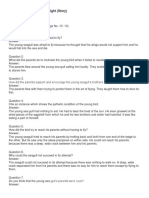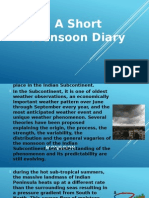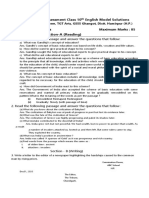Tsunami Case Study
Tsunami Case Study
Uploaded by
Natarajan MuruganCopyright:
Available Formats
Tsunami Case Study
Tsunami Case Study
Uploaded by
Natarajan MuruganOriginal Description:
Copyright
Available Formats
Share this document
Did you find this document useful?
Is this content inappropriate?
Copyright:
Available Formats
Tsunami Case Study
Tsunami Case Study
Uploaded by
Natarajan MuruganCopyright:
Available Formats
Case Study: 2004 Indian Ocean earthquake and tsunami
2004 Indian Ocean earthquake
Date Magnitude Depth Countries or regions Tsunami Casualties
00:58:53, 26 December 2004 9.19.3 30 km Indonesia ,Sri Lanka, India (mostly in Tamil Nadu) Thailand Maldives) Yes 230,210 280,000( deaths recorded history)
The 2004 Indian Ocean earthquake was an undersea megathrust earthquake that occurred at 00:58:53 on Sunday, 26 December 2004, with an epicentre off the west coast of Sumatra, Indonesia. The quake itself is known by the scientific community as the SumatraAndaman earthquake. The resulting tsunami is given various names, including the 2004 Indian Ocean tsunami, South Asian tsunami, Indonesian tsunami, and Boxing Day tsunami. The earthquake triggered a series of devastating tsunamis along the coasts of most landmasses bordering the Indian Ocean, killing over 230,000 people in fourteen countries, and inundating coastal communities with waves up to 30 meters (98 ft) high. It was one of the deadliest natural disasters in recorded
history. Indonesia was the hardest-hit country, followed by Sri Lanka, India, and Thailand.
Possible human component in magnitude of damage Andrew Browne, argued that the human destruction of coral reefs may have played a role in exacerbating the destruction caused by the tsunami. Many countries across Asia, including Indonesia, Sri Lanka and Bangladesh, have put forth efforts to destroy the coral surrounding their beaches, and instead make way for shrimp farms and other economic choices. Many reefs areas around the Indian Ocean have been destroyed using dynamite because they are considered impediments to shipping, an important part of the South Asian economy. Similarly, Browne argued that the removal of coastal mangrove trees may have intensified the effect of the tsunami in some locations. He argued that these trees, which lined the coast but were removed to make way for coastal residences, might have lessened the force of the tsunami, in certain areas. Beyond the heavy toll on human lives, the Indian Ocean earthquake has caused an enormous environmental impact that will affect the region for many years to come. It has been reported that severe damage has been inflicted on ecosystems such as mangroves, coral reefs, forests, coastal wetlands, vegetation, and rock formations, animal and plant biodiversity and groundwater. In addition, the spread of solid and liquid waste and industrial chemicals, water pollution and the destruction of sewage collectors and treatment plants threaten the environment even further, in untold ways. The environmental impact will take a long time and significant resources to assess.
Q1 ) Analyse the above environmental impact situation. Q2) Give the Role played by man in this damage.
You might also like
- Wildlife Sanctuaries in India ListDocument5 pagesWildlife Sanctuaries in India Listsritamk95No ratings yet
- Climate Species MatrixDocument13 pagesClimate Species Matrixapi-686757142No ratings yet
- Pome 8 The Axe in The WorldDocument2 pagesPome 8 The Axe in The WorldChannappa BadigerNo ratings yet
- Unit 1 Chapter 1 His First Flight (Story)Document10 pagesUnit 1 Chapter 1 His First Flight (Story)vghbNo ratings yet
- SCRIPT of The Topic: Enumerate The Lines of Evidences That Support Plate MovementDocument6 pagesSCRIPT of The Topic: Enumerate The Lines of Evidences That Support Plate Movementjanice alquizar100% (4)
- Who Will Be NingthouDocument1 pageWho Will Be Ningthourafiuddin syedNo ratings yet
- A Short Monsoon DiaryDocument22 pagesA Short Monsoon Diaryapi-276627294No ratings yet
- NCERT Class 7 English Part 2Document75 pagesNCERT Class 7 English Part 2Narmadha RameshNo ratings yet
- CLASS 7 CH 8 Life in Tropical Sub-TropicalDocument6 pagesCLASS 7 CH 8 Life in Tropical Sub-TropicalAnuragNo ratings yet
- Climate: Difference Between Weather and Climate Factors Effecting The ClimateDocument18 pagesClimate: Difference Between Weather and Climate Factors Effecting The ClimateMuhammad Jamal QureshiNo ratings yet
- GGSIPU B.Ed. - Multimedia Lesson Plan - Inside Our Earth - Class 7th-GEOGRAPHY PPT NCERT/CBSEDocument28 pagesGGSIPU B.Ed. - Multimedia Lesson Plan - Inside Our Earth - Class 7th-GEOGRAPHY PPT NCERT/CBSEashwinkumarvermaofficialNo ratings yet
- Class VIII English - Information Sheet Poem - I Wish I'd Looked After Me Teeth 26.07.2021Document2 pagesClass VIII English - Information Sheet Poem - I Wish I'd Looked After Me Teeth 26.07.2021Kusum Lata DabasNo ratings yet
- The Invention of Vita-WonkDocument11 pagesThe Invention of Vita-WonkAnzela ThapaNo ratings yet
- Geography: CLASS: 10 Lesson: Soils of IndiaDocument5 pagesGeography: CLASS: 10 Lesson: Soils of IndiaTRIJAL SRIMAL0% (1)
- Rupam Class 8chapter 3 Glimpses of The PastDocument10 pagesRupam Class 8chapter 3 Glimpses of The PastShivam Singh Shiva100% (1)
- Section A: Reading Comprehension (40 Marks) Instruction: Read The Following Passage and Answer The Questions That Follow. ChessDocument7 pagesSection A: Reading Comprehension (40 Marks) Instruction: Read The Following Passage and Answer The Questions That Follow. ChessCML Centre of Modern LanguagesNo ratings yet
- 10th Standard English Action PlanDocument3 pages10th Standard English Action PlansanthoshNo ratings yet
- English A Tiger in The House PDFDocument3 pagesEnglish A Tiger in The House PDFMadhu ChandraNo ratings yet
- English - Unit 8Document19 pagesEnglish - Unit 8Lakshmi Saranya GollapudiNo ratings yet
- Class 8 Winter Break Home-WorkDocument8 pagesClass 8 Winter Break Home-Workrani bloriaNo ratings yet
- Chennai Public School: English-Class ViiiDocument2 pagesChennai Public School: English-Class ViiiAbishek ThiyagarajanNo ratings yet
- Class 8 Holiday's HomeworkDocument7 pagesClass 8 Holiday's Homeworkashishmehra040709No ratings yet
- Class 11 Eng - Note MakingDocument4 pagesClass 11 Eng - Note MakingSUB IS HERENo ratings yet
- No Men Are ForeignDocument32 pagesNo Men Are ForeignKolammal Sankar100% (1)
- MDP ViDocument8 pagesMDP ViAmar PandyaNo ratings yet
- Solved Term Exam Paper 10th Eng HP Dec 2020 by Vijay HeerDocument8 pagesSolved Term Exam Paper 10th Eng HP Dec 2020 by Vijay HeerVIJAY KUMAR HEERNo ratings yet
- G9 - Ch. Sound - PPTDocument11 pagesG9 - Ch. Sound - PPTAshish GambhirNo ratings yet
- My Childhood by Apj Abdul KalamDocument3 pagesMy Childhood by Apj Abdul KalamshirinNo ratings yet
- Patol BabuDocument15 pagesPatol BabuakjNo ratings yet
- Quality Class 7Document2 pagesQuality Class 7Harika CNo ratings yet
- Lesson - 14 When The Earth Shook SupplementaryDocument7 pagesLesson - 14 When The Earth Shook SupplementarySubodh Kumar singhNo ratings yet
- 10th STDDocument7 pages10th STDManjunath HSNo ratings yet
- (20771) The Cherry Tree - NB InstructionsDocument3 pages(20771) The Cherry Tree - NB InstructionsManoj Kumar100% (1)
- CBSE Class 7 English Sample Paper 2018 PDFDocument7 pagesCBSE Class 7 English Sample Paper 2018 PDFP N ShanmugamNo ratings yet
- 3 A Photograph Notes For Notebook XIDocument12 pages3 A Photograph Notes For Notebook XIParveen kumarNo ratings yet
- The King and The Tree GoddessDocument4 pagesThe King and The Tree GoddessTanvi SaraffNo ratings yet
- Somebody's MotherDocument6 pagesSomebody's Motheraahanaagarwal310No ratings yet
- GARDEN SNAKE - PPSXDocument17 pagesGARDEN SNAKE - PPSXSutapa Biswas67% (3)
- V OCATIONDocument3 pagesV OCATIONYesha ShahNo ratings yet
- Read The Following Text-1Document20 pagesRead The Following Text-1aditya007hai0% (1)
- TEXT EXERCISES Rani GaidinliuDocument8 pagesTEXT EXERCISES Rani GaidinliuADITYASANKAR R 1305010021No ratings yet
- Descriptive Paragraph Class 9Document5 pagesDescriptive Paragraph Class 9shushilabhutraNo ratings yet
- 7th Geography Chapter 8Document14 pages7th Geography Chapter 8The mastero100% (1)
- No Men Are Forigen Ques-AnsDocument6 pagesNo Men Are Forigen Ques-AnsKhushNo ratings yet
- Class V - Eng - Module 2 - L 1Document4 pagesClass V - Eng - Module 2 - L 1Srinivasa Reddy KarriNo ratings yet
- India Climate Notes BKLDocument12 pagesIndia Climate Notes BKLchivukula Karthik100% (1)
- Ch-4 What Books and Burials Tell UsDocument5 pagesCh-4 What Books and Burials Tell UsPriya ChughNo ratings yet
- 4.the Ant and The CricketDocument5 pages4.the Ant and The Cricketkrishnagiri distttaNo ratings yet
- 3.1 Coromandel FishersDocument4 pages3.1 Coromandel FishersVonn DuboseNo ratings yet
- 09 Eng Comm SP 01Document10 pages09 Eng Comm SP 01ridhigulati2009No ratings yet
- Lake Isle of Innisfree Lesson Plan BV ZGDocument4 pagesLake Isle of Innisfree Lesson Plan BV ZGapi-266111651100% (1)
- Class X English Project 2024-25Document1 pageClass X English Project 2024-25Sweta TibrewalNo ratings yet
- GEOGRAPHY ProjectDocument27 pagesGEOGRAPHY ProjectNew UserNo ratings yet
- Presentation On National Parks: Presented By-Akanksha Katiyar Neha VarshneyaDocument9 pagesPresentation On National Parks: Presented By-Akanksha Katiyar Neha VarshneyasarjueNo ratings yet
- Coursebook: Chapter 1: Three QuestionsDocument35 pagesCoursebook: Chapter 1: Three QuestionsBhatia Parul100% (1)
- Villa For Sale - ExerciseDocument5 pagesVilla For Sale - ExerciseHardik GulatiNo ratings yet
- Weather and ClimateDocument27 pagesWeather and ClimateRIA SEKHRINo ratings yet
- The Sound of Music - The Shehnai of Bismillah Khan (PPT 1)Document23 pagesThe Sound of Music - The Shehnai of Bismillah Khan (PPT 1)aarav100% (1)
- Natural Regions of The WorldDocument3 pagesNatural Regions of The Worldshrey jainNo ratings yet
- English Footprints Without Feet WorksheetDocument1 pageEnglish Footprints Without Feet Worksheetvikas aggarwal100% (1)
- Yr 8 Geo Assessment Task T1Document3 pagesYr 8 Geo Assessment Task T1devesh.shivathmajanNo ratings yet
- 2004 TsunamiDocument11 pages2004 TsunamilagisworstNo ratings yet
- Rajat GuptaDocument8 pagesRajat GuptaNatarajan Murugan100% (1)
- Culture and Ethics, Cross-Cultural Set Up, Ethics in International Scenario, - Attitude, Perception, Belief, Ego States and Life PositionsDocument27 pagesCulture and Ethics, Cross-Cultural Set Up, Ethics in International Scenario, - Attitude, Perception, Belief, Ego States and Life PositionsNatarajan MuruganNo ratings yet
- Current Liabilities - TopicsDocument24 pagesCurrent Liabilities - TopicsNatarajan MuruganNo ratings yet
- Jaipur FootDocument14 pagesJaipur FootNatarajan MuruganNo ratings yet
- INDEPP Marine Spatial Planning Report TNDocument214 pagesINDEPP Marine Spatial Planning Report TNBaalaji RavichandranNo ratings yet
- Estimation of Reservoir CapacityDocument4 pagesEstimation of Reservoir CapacityNani TirumalasettiNo ratings yet
- 3331 Lecture6 GlobalCirculation F13Document30 pages3331 Lecture6 GlobalCirculation F13Trevor ChadNo ratings yet
- 4 - O-Pitblast - Topography ModuleDocument29 pages4 - O-Pitblast - Topography ModuleJorge Luis UCNo ratings yet
- Rooftop Rainwater HarvestingDocument21 pagesRooftop Rainwater HarvestingAshirNo ratings yet
- Gis Flood MGMTDocument12 pagesGis Flood MGMTPooja100% (1)
- C V Bassem Nabawy 16-8-2008Document5 pagesC V Bassem Nabawy 16-8-2008bsnabawy@yahoo.co.uk100% (2)
- Occurrence of Gold, Its Association and Nature of Mineralization in Timmanahalli Area of Chitradurga Schist Belt, Dharwar Craton, KarnatakaDocument13 pagesOccurrence of Gold, Its Association and Nature of Mineralization in Timmanahalli Area of Chitradurga Schist Belt, Dharwar Craton, KarnatakabhupenderNo ratings yet
- Introduction To Environmental EngineeringDocument11 pagesIntroduction To Environmental EngineeringJeric WaldoNo ratings yet
- BiodiversityDocument39 pagesBiodiversitysaloni bhardwajNo ratings yet
- Ohia Tree Endemic Species ReportDocument6 pagesOhia Tree Endemic Species Reportapi-527504533No ratings yet
- Geographical 07 2024Document84 pagesGeographical 07 2024Alaeddine SaadaouiNo ratings yet
- 5.1 Rational MethodDocument15 pages5.1 Rational Methodjohn rey toledoNo ratings yet
- Course Basin Analysis Workshop An Integrated Approach To The Exploration and EvaDocument4 pagesCourse Basin Analysis Workshop An Integrated Approach To The Exploration and EvaJabir JammyNo ratings yet
- 2022.08.30 Presentation Sinarmas Land (Benowo) ReviewDocument74 pages2022.08.30 Presentation Sinarmas Land (Benowo) ReviewTeddy SusantoNo ratings yet
- Dhulian FinalDocument50 pagesDhulian FinalShams Sardar100% (2)
- NorthEast Monsoon Seasonal Report - 2016Document103 pagesNorthEast Monsoon Seasonal Report - 2016404No ratings yet
- Climb Every Mountain in GDocument1 pageClimb Every Mountain in GbagawbawNo ratings yet
- Water Crisis: Causes, Implications and ResolutionsDocument6 pagesWater Crisis: Causes, Implications and ResolutionsHadryan HalcyonNo ratings yet
- Remarks: Assumed AHFL Is Valid: 3.1 M 3 Coefficeint of Discharge For Broad CrestedDocument3 pagesRemarks: Assumed AHFL Is Valid: 3.1 M 3 Coefficeint of Discharge For Broad CrestedKumar VivekNo ratings yet
- Course AIR POLLUTIONDocument3 pagesCourse AIR POLLUTIONikhwanstorageNo ratings yet
- Pertemuan 4 - Suspended Growth - NFTDocument35 pagesPertemuan 4 - Suspended Growth - NFTNURINA FITRIANINo ratings yet
- Lukuga Barrage Draft Design Report-30!09!2013Document51 pagesLukuga Barrage Draft Design Report-30!09!2013sushant bhadriNo ratings yet
- South AmericaDocument13 pagesSouth AmericaAbhilokeet SherchanNo ratings yet
- Q4 Science 7 Week3Document4 pagesQ4 Science 7 Week3bry kaligayahanNo ratings yet
- WG ClassworkDocument23 pagesWG ClassworkIcecream Draems100% (1)
- ADYAR - 2023 Prestorming ScheduleDocument9 pagesADYAR - 2023 Prestorming Scheduleyt HehkkeNo ratings yet
- Farinha - Opportunity Cost 2019Document9 pagesFarinha - Opportunity Cost 2019clandioruviaroNo ratings yet





























































































